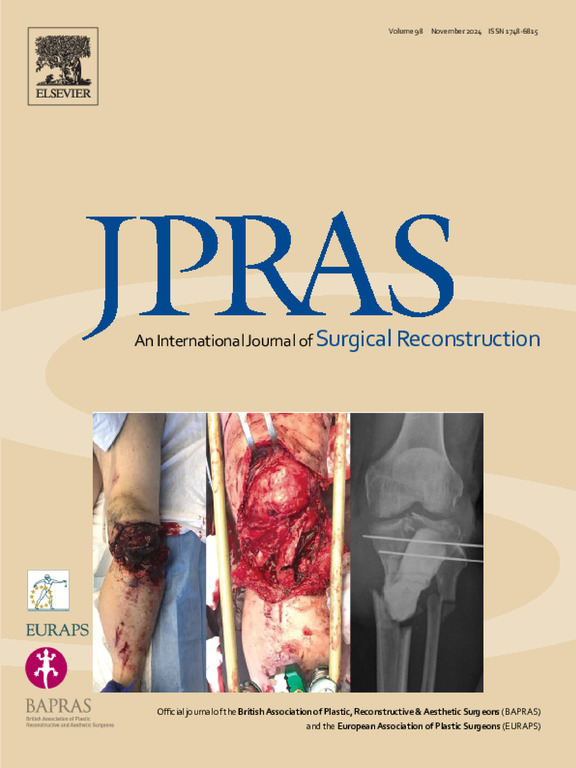Nipple malposition following nipple sparing mastectomy: Evaluation of secondary correction in prepectoral implant-based breast reconstruction
IF 2
3区 医学
Q2 SURGERY
Journal of Plastic Reconstructive and Aesthetic Surgery
Pub Date : 2025-04-02
DOI:10.1016/j.bjps.2025.03.056
引用次数: 0
Abstract
Ptosis can be a relative contraindication to nipple sparing mastectomy (NSM). Although a mastopexy-type approach can be performed during mastectomy, this requires very well perfused skin flaps and possibly intraoperative adjustments with the oncological breast surgeon. The purpose of this study is to assess risk factors that result in the nipple surgically raised secondarily in standard NSM with prepectoral tissue expander (TE) reconstruction to help guide surgical decision-making and patient counseling.
Patients at our center who underwent NSM and immediate prepectoral TE reconstruction were assessed. Patients who had immediate nipple position adjustment during the day of the mastectomy were excluded. Patients were divided into two groups: Group 1 (secondary nipple adjustment during the second stage) and Group 2 (no secondary nipple adjustment). Preoperative sternal notch-to-nipple distance, Regnault classification ptosis grade, brassiere size, and mastectomy weights were assessed.
The study included 158 patients: 33 patients in Group 1, 125 patients in Group 2. Grade II ptosis was present in 84.8% (28/33) of Group 1 compared to 58.4% (73/125) of Group 2 (p=0.0044). The average preoperative sternal notch-to-nipple distance for Group 1 was 26.2±2.6 cm compared to 24.7±3.9 cm for Group 2 (p=0.002). There was no difference in preoperative cup size between groups (p=1). The average mastectomy weight in Group 1 was 542.6±207.6 g compared to 449.4±264.3 g (p=0.03).
Patients with grade II ptosis, sternal notch-to-nipple >26 cm, and larger breast size who undergo standard NSM are more likely to require secondary nipple correction. The findings can improve patient counseling and expectations.
保留乳头乳房切除术后乳头错位:乳前假体乳房再造术二次矫正的评价
上睑下垂可能是乳头保留乳房切除术(NSM)的相对禁忌症。虽然在乳房切除术中可以采用乳腺增生型方法,但这需要非常好的皮瓣灌注,还可能需要肿瘤乳腺外科医生进行术中调整。本研究的目的是评估在标准 NSM 和胸前组织扩张器(TE)重建术中导致乳头手术二次隆起的风险因素,以帮助指导手术决策和患者咨询。本中心对接受 NSM 和即刻胸前 TE 重建术的患者进行了评估,并排除了在乳房切除术当天立即进行乳头位置调整的患者。患者被分为两组:第一组(在第二阶段进行乳头二次调整)和第二组(不进行乳头二次调整)。对术前胸骨切迹到乳头的距离、Regnault分类下垂等级、胸罩大小和乳房切除术体重进行了评估:第 1 组中有 84.8%(28/33)的患者存在 II 级上睑下垂,而第 2 组中有 58.4%(73/125)的患者存在 II 级上睑下垂(P=0.0044)。第一组患者术前胸骨切迹到乳头的平均距离为(26.2±2.6)厘米,第二组为(24.7±3.9)厘米(P=0.002)。组间术前乳杯大小无差异(P=1)。第1组的平均乳房切除重量为(542.6±207.6)克,而第2组为(449.4±264.3)克(P=0.03)。II度下垂、胸骨切迹至乳头>26厘米、乳房尺寸较大的患者接受标准NSM后,更有可能需要二次乳头矫正。这些发现可以改善对患者的咨询和期望。
本文章由计算机程序翻译,如有差异,请以英文原文为准。
求助全文
约1分钟内获得全文
求助全文
来源期刊
CiteScore
3.10
自引率
11.10%
发文量
578
审稿时长
3.5 months
期刊介绍:
JPRAS An International Journal of Surgical Reconstruction is one of the world''s leading international journals, covering all the reconstructive and aesthetic aspects of plastic surgery.
The journal presents the latest surgical procedures with audit and outcome studies of new and established techniques in plastic surgery including: cleft lip and palate and other heads and neck surgery, hand surgery, lower limb trauma, burns, skin cancer, breast surgery and aesthetic surgery.

 求助内容:
求助内容: 应助结果提醒方式:
应助结果提醒方式:


